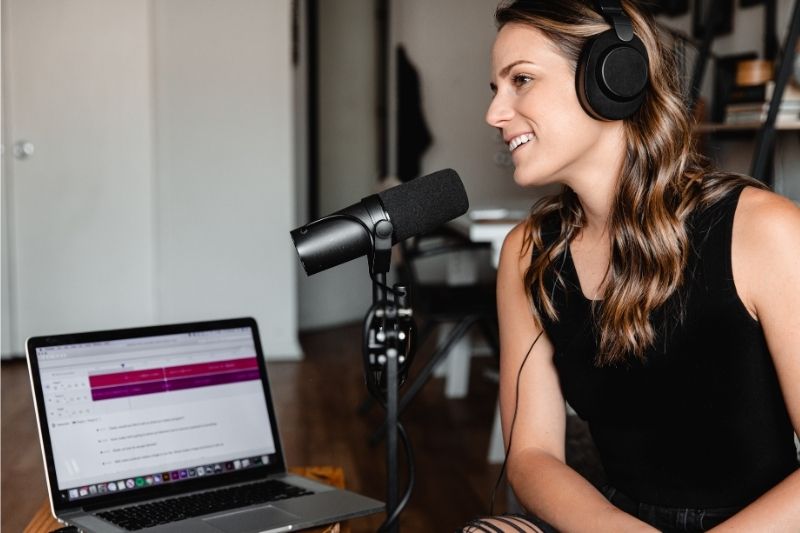No products in the cart.
How to Create Podcasts for Your Business

Famous author and online entrepreneur, Seth Godin recently stated that “Podcasting is the new blogging.” Podcasts are now a big deal for business owners and marketing professionals. (Image Credit: Soundtrap/Unsplash)
Podcasts are one of the newest ways to share your ideas, lead a community, and earn trust. These all sound amazing in terms of marketing a business, so why do so many businesses still not produce a podcast?
There are undoubtedly concerns about maintaining brand-image and professionalism which could be impacted by a low-quality product/show. Issues also exist with having the time, money, and resources to hire or train someone to produce a series of podcasts. This is especially true as the COVID-19 pandemic has hit a lot of companies pretty hard.
However, everyone is blogging and everyone is knocking out a Youtube channel. As such it may be that podcasting may offer a unique and effective way to reach target audiences and build a business’s brand. Indeed, the simple fact that podcasts are tricky to produce & promote makes them potentially much more powerful. After all, a written blog post often gets published into the void of billions-of-blogs on the internet.
Equipment Needed to Set up a Solo Podcast
You could get started and make a test podcast for your personal brand/just for fun without any equipment. However, if you are creating podcasts that will effectively be representing your company and your brand, then you want to make sure it is highly professional. With this in mind, you will need to invest in some podcast equipment.
-
Microphone
The USB microphone is the simplest to use. Just plug it into the USB port on your computer and the computer will then usually automatically sync the microphone to the relevant software. And away you go! You are ready to record.
Look for a microphone with a built-in headphone jack so you can adjust the volume of your voice in real-time.
However, if your podcast will include more than one person, you should not use USB microphones. Problems have been noted with the microphones and the device it is recording to.
Instead, use dynamic or condenser microphones that plug into separate devices. Dynamic mikes reject background noise quite efficiently. This can also be advantageous when there is more than one person on the podcast. Condenser mics, on the other hand, are better suited to quiet or professional recording studios where background noise is kept to a minimum.
-
Software
Audacity is the go-to, free software for editing podcasts. Bonus – free! You can simply download it from their website. It has a lot of editing capabilities: you can compress, you can normalize, you can create fades. The only downside is that there can be some issues with bugs. For example, recently, when Apple updated the main OS to Catalina, Audacity completely broke!
Be aware that, by default, it uses “destructive editing.” This basically means that you’ll never be able to restore something that was deleted.
GarageBand – this comes preinstalled on most Apple devices. It’s free and its relatively easy to use compared to Audacity. However, it does have limited exportation capabilities. You can’t really edit the file or tweak it too much when you export it. It also doesn’t allow you to adjust the loudness levels.
Alitu – an internet-based piece of editing and recording software that will work with any device. The Alitu interface is very easy to use. Moreover, for the beginner, it can be very helpful in that it will do some automatic mixing and editing for you, allowing you to match different audio clips that you drag into the interface.
Getting Your Podcast Out There
One of the best ways to get your brand and your podcast established is to go on other podcasts as a guest. Unlike an advert, which may appear for 30 seconds on a podcast, actually being part of the podcast and the show itself will normally get you accepted by the audience. They will have time to get to know you, your podcast, and what you are about. It’s not something that they will forget or disregard a few minutes later like a generic advert. There is more incentive for them to go and listen to you again.
A good way to capitalize on such an audience is to provide them with lots of useful information. Then, create a specific webpage that summarises all the information for them. You can then give the webpage a specific address so they can find it easily on Google or via a link in the podcast’s description or notes.
Send an email out to your blog subscribers when you have uploaded a podcast. Ideally, segment your email list and email the people who are most likely to be interested in a particular episode. If your content is quality, then you shouldn’t annoy your audience.
You can also use social media ads. However, this can get expensive and can be difficult to track. If you are a guest on someone else’s podcast, you can offer to promote a post for them, even if it’s just by $50. The increase in reach can often be significant.
Try repurposing your show. Take the audio file and the transcript and create a specific blog post for each podcast episode. Take specific clips from each episode and use it on social media. Add text to the clips so they can be understood without the audio.
Ideally, you want to get people to subscribe to your podcast. Embed Smart Podcast Player on your blog post. It can help you build your email list organically.
Using a Podcast to Drive Sales
Podcasting offers more as a branding venture than a direct sales tool. Branding is often underutilised or unappreciated. However, without a brand, you will never get off the treadmill of paying for traffic with ads.
A podcast, first and foremost, must offer value to the listeners. Nobody will want to listen to your podcast if you continually push your products. Instead, the aim should be to establish yourself and your organisation as an authority in a particular niche or industry.
For example, if you are a personal trainer, you can earn trust, respect and future clients by showcasing your expertise on your podcast. At the end of the podcast, you could add a subtle call to action such as “if you need any further help or information, visit my website or call me on…”
If you don’t have a business website set up yet, then you can easily put one together using WordPress or hire someone to do it for you on a site like Peopleperhour. As an aside, you may also want to invest in a telephone answering service or app from a company such as Moneypenny. After all, you probably don’t to be taking calls from someone who is listening to your podcast at 2 am on a Wednesday!
Create Your Own Category
Tim Ferris, in 2017, recommended creating a category and dominating it, rather than trying to fit into an already established category. For example, Bud Light hit the market in 1987, over 60 years after Heineken. However, Bud become the most successful light beer in America because it promoted its own category as a domestic beer above the actual product itself. The category was more influential than the quality of the product.
Bud didn’t necessarily look to create a better product. They differentiated themselves by producing a more favorable category of product. You can do this with your podcast and/or product too. What’s new and what’s first often captures people’s attention. Read more in this summary of the 22 Immutable Laws of Marketing on Medium.com.
Scratch Your Own Itch
Also, consider making the podcast for yourself. Create something that you find interesting or something you can’t find. For example, if you are a 35-year-old single man, you may not want to make a podcast about family life. However, if you have a passion for fitness and you can’t find much free advice on gut health and immunity, then create podcasts that address those things.
1,000 True Fans
Try to establish 1,000 fans. That is all you need. They will become a marketing force for all your podcasts by themselves. By targeting a need and a niche and providing as much quality and useful information as possible, you will gain fans for your podcast.










Leave a Reply